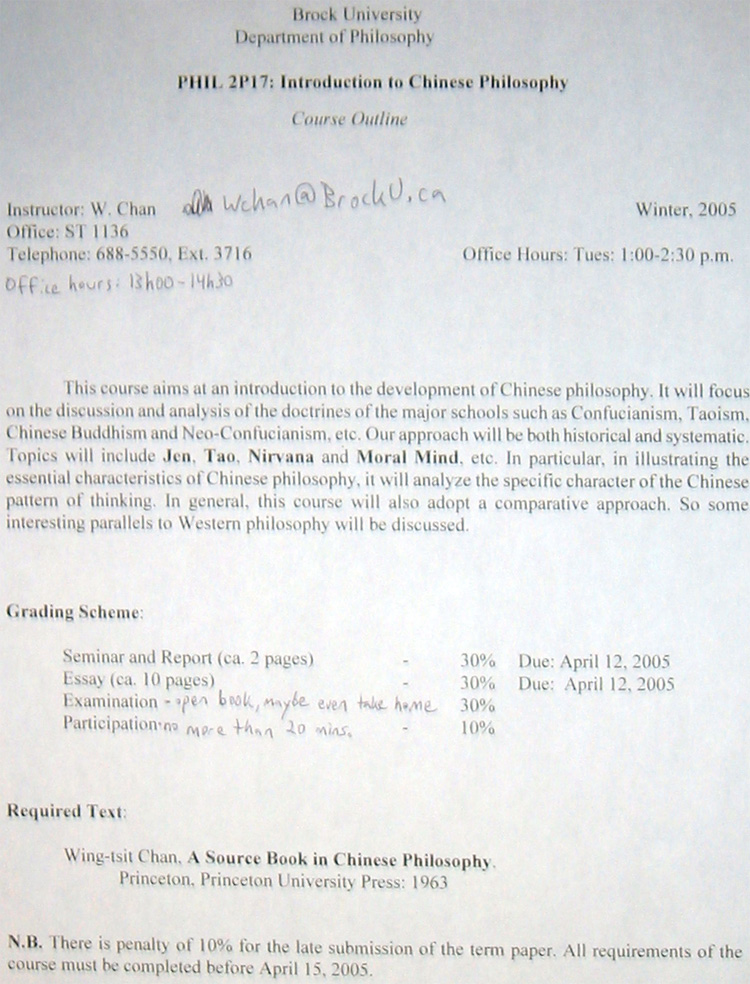
Hand-outs: Zen Buddhism (Southern School oriented presentation, including a summary on the Platform Scripture)

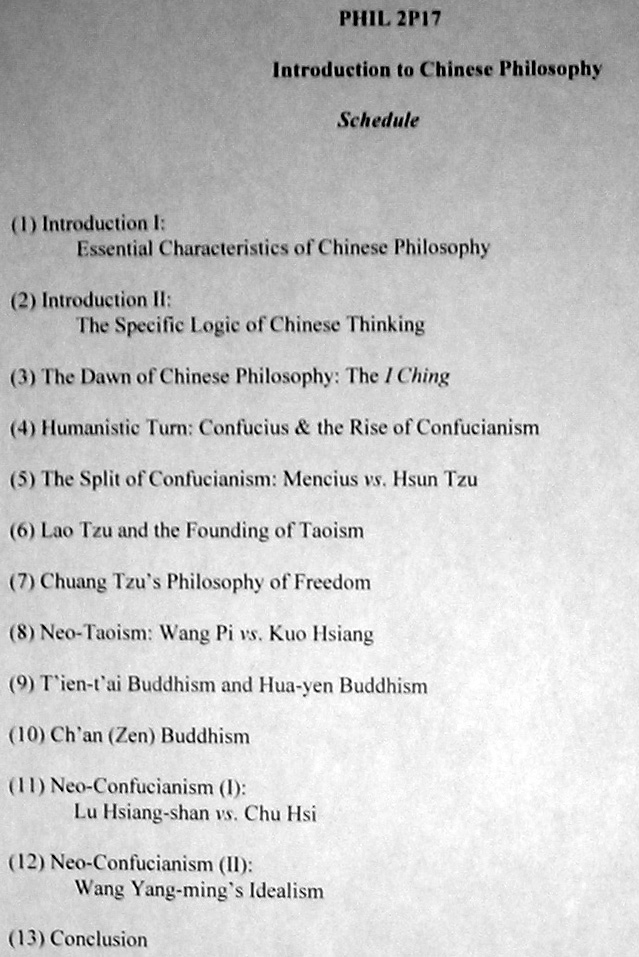
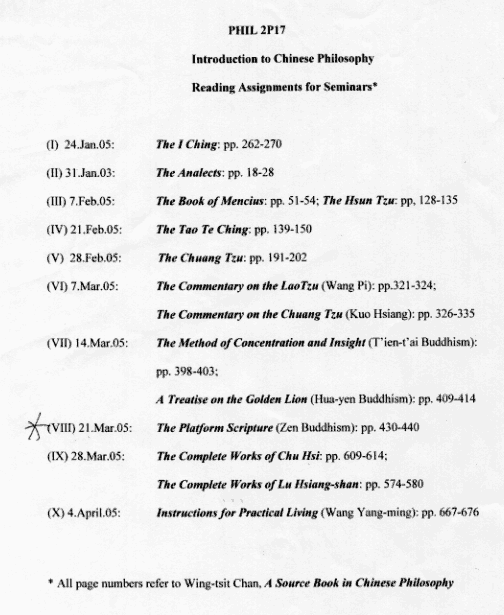
3 major schools of 'thought': Confucionism, Taoism, and Buddhism. Though the last one, Buddhism, originated from India.
Chinese Buddhism is a combination of Chinese Philosophy and Buddhism.
Recently, especially in Japan, there is a rise of Critical Buddhism. According to Critical Buddhism, Chinese Buddhism is pseudo-Buddhist. Professor Chan disagrees, and will explore this topic further. It has nothing to do with nationality, but rather philisophical issues.
Chronologically, the rise of Confucionism is the first.
I Ching is still one of the most popular texts in China. It is a popular fortune-telling book. Represents a cosmological system. We will understand this text strictly philisophically. Related to Nature and human beings.
Confuscious is the first philosopher in Chinese history. Related more to society – humanistic. Ethical relation between individuals (interpersonal) and/or relation between individuals and society.
Jen: character translated as 'man' and 'two'. Humanity, benevolence
Taoism: Important concept is Tao. One translation is 'way' related to 'how' for philosiphising. Tao is beyond any computational method, beyond the power of any computer (too much to model?).
According to Martin Heidegger (1889-1976) the essence of the age of technology is danger. Danger means surprises. Modern man is enslaved by technology, imprisoned. For technology we will forgo our well-being. The only way to overcome a danger of the age of technology is to listen to Tao. With advancement of technology we can capture methods, but never the Tao.
Kant – philosophy is unteachable
Socrates – as a teacher in philisophy teachers should work like a midwife helping the student develop their own talent
According to Tao, if you know how to raise the 'how' question, then you are able to philosiphise.
Second meaning of Tao is 'speech'/'language'. One work of Heidegger is titled “On the way toward language”.
A lot of major concepts of Buddhism are in Sanscript. One of the major concepts is Nirvana. Etymological meaning is 'End of Suffering'.
Today, Indian Buddhism is totally gone, according to Prof. Chan. He will explain why later on. Hinduism is the Orthodox in India, and they are glad Buddhism is gone; it was the 'other', the 'enemy'. With regards to Brahma(God)nism, Buddhists recognize no God as their creator, which was welcomed by the Chinese; it fits their mentality. Chinese Buddhism is unique in the sense that you can never find it in India.
In Chinese Buddhism there are three major schools. Chronologically, T'ien-t'ai Buddhism, next was [something I didn't understand], and then Ch'an (Zen) Buddhism. The original temple for the first-mentioned school still exists, and there is a mountain with that name. Middle is from Indian Scripture, Chinese interpretation. Ch'an is pretty much gone in China, but found in Japan.
Prof. Chan recommends going to Japan if you are studying Buddhism.
Buddhism is extremely critical of a hiearchical society. In an ideal society, in the Buddhist sense, must be egalitarian. Brahmanism and Buddhism both used Sanscript, but Shakyamuni taught in the local Thai dialect. It's dangerous that each use the same language, since the meanings get distorted between them.
Four major periods in Chinese
Philosophy:
(slides shown by Professor Chan on an overhead/laminate projector will generally be displayed as black text on white background):
|
Pre-Ch'in' |
Wei-Ch'ing |
S'ui-T'ang |
Sung-Ming |
|---|---|---|---|
|
7th-3rd BC |
3rd-5th AD |
6th-10th AD |
10th-17th AD |
|
Confucianism* Taoism* Mohism The Logic school* Legalism |
Neo-Taoism (in reaction to Buddhism)* |
Chinese Buddhism* |
Neo-Confucianism* |
* We'll focus on these schools, for others, see The Source Book.
The I Ching is Confucian. Lao Tzu is the author of Tao-te Ching of Tao. Chuang Tzu is the 2nd major founder of Taoism. His text is self-titled, Chuan Tzu. Wang Pi died at 23 and his work is very important to Neo-Taoism. Wang Yang-ming has been identified as the last philosopher in Chinese Traditional Philosophy, but Prof. Chan disagrees (he thinks there is one more guy since then: See chapter 36, page 692 Wang Fu-chih (1619-1692)).
Yu-lan Fung, A History of Chinese Philisophy. Originally in Chinese in two volumes. Published by Princeton University Press. 1952
Like a modern version of Plato. Prof. Chan will use some material from [t]his text.
Hedon (Greek for happiness)
Immenent telos of Chinese Philosophy: Harmony (connected with balance), the perfect balance among different things.
What is Harmony?Harmony vs. Identity
|
The 'Other' is most important concept in post-modern philosophy
Harmony is created, identity is non-productive. Harmony is like oneness, the one in the many, unity in difference. Identity implies the exclusion of other, uniqueness.
Prof. Chan says that for the USA, terrorism is the other, and once they eliminate terrorism there is no other.
Chinese Philosophy is a philosophy of Harmony (inauthentic). It is not a philosophy of identity. In a downside (like during it's development), it becomes a philosophy of identity (authentic).
Leibniz (1646-1716) was mainly interested in the I Ching. Developed another definition for Harmony, a Western definition:
"Harmonia est diversitas identitate compensata. Sed Harmonicum est uniformitor difforme"
"Harmony is a balanced identity of difference. Or, Harmony is the uniform diversity"
Harmony is the unity [of identity] of the many
apart from other, there is no harmony
concept of proportionality is important.
Logic, the pattern of Chinese thinking... How to reach harmony is the most important task of the Chinese philosophers. How to attain this? Eventually you come to the idea of proportionality. Analogy is the next logical step. Ana(according to) Logon(comes from Logus) in Greek.
Proportionality will come up later. On to other things...
back to our topic, Chinese Logic:
Theory of reasoning/inference.
| All A are B | <- this is a premise | |
| All B are C | <- this is also a premise | |
| Therefore All A are C | <- the conclusion |
The table above demonstrates Syllogism - [definition on Dictionary.com]
Aristotle started that formal logic stuff. "This form of reasoning only in the Western world." So, what is Chinese Logic??
Pattern of thinking -> Logic = theory of inference. It's the product, like the cooked dish on the table. In order to attain the goal of harmony, the Chinese Philosophers thought in a certain way. The result is Chinese Logic.
Chan says there are only 3 kinds of thinking (his theory/thesis) - 3 patterns of thinking: Three Basic Types of Logic:
| SIGN THINKING | LOGIC PATTERN OF | |||||||
| Icon | Chinese Logic - Analogical | |||||||
| Index | Indian Logic - Indicative:
|
|||||||
| Symbol | Western Logic - Deductive |
|||||||
Charles Peirce (1839-1914) "The only genius of Philosophy in America"
Semiotics = study of signs
Note: As of this writing (2005-04-10), the only thing I could find on Google by searching "sign thinking" icon index symbol was 1 Word Document (with no clear author and titled "ASA Conference 2003 The Problem of Culture") that I saved for reference from some seemingly-abandoned (not updated since 2002) web-site for "MSSRbooks"
Analogy --> creative thinking
Prof. Chan gives analogy of N. Bohr using the solar system as an analogy for atomic theory.
Basically understood in terms of similarity.
Back to SIGN THINKING (Peirce)... What is an Icon? Madonna is the icon of some music, Einstein is the icon of some science, Ghandi and Indian culture...
Chinese language is basically iconic. Why is Chinese Logic analogical?
Deduction: When the premesis is true, the conclusion must be true.
Max Weber was the founder [the father] of Sociology, German Sociology. Part of Modernity is rationalization. Rationalization is related to the rise of Capitalism. Doing business in the capitalist way is rational, according to Max Weber. Capitalism is the typical product of Western civilization. According to Weber, Confucianism and Taoism resulted in the Chinese failing in producing Capitalism, same as with Indian/whatever and Middle East and Islam. Capitalism in the West is the result of Christianity, Protestant ethics. Michel Foucault forefather of Post Modernism raised the same question, asked Why only in the West there is a science of sexuality? Rise of Freudian analysis is the first example of this. Chinese identified sexuality as a technique, related to Chinese medicine. Sexuality as a technique in prolonging life. Chinese don't identify sexuality as an object of scientific knowledge. In India, sexuality has been identified as an art, a means of attaining enlightenment, serving religion.
Why is Chinese Logic analogical? The language underlies the way of thinking, serving basic principle of similarity.
Who is Kung-sun Lung?Kung-sun Lung (319-252 BCE) was a dialectician of the time of the Six States (i.e. Warring States). Dissatisfied with the divergence and confusion between names and the actuality of their references, he used his peculiar talent to insist the distinctive character of whiteness. In terms of taking things as examples, he argued on this theme of autonomy of whiteness. Accordingly, he declared that a white horse is not a horse. He wished to extend his argument so as to rectify names with the actuality of their references, and this to transform the whole world. He failed to demonstrate this logic successfully to people. Chan goes on to tell something about Sophist arguers who use paradoxical points to confuse who they argue with. A White Horse is not a Horse Argument I: The word 'horse' denotes shape, 'white' denotes color. What denotes color does not denote shape. Therefore, a white horse is not a horse. Argument II: When a horse is required, yellow and black ones may all be brought forward, but when one requires a white horse, a yellow or black horse cannot be brought forward. Therefore, yellow and black horses are each separate kind, and can respond to the call for a horse, but not to the call for a white horse. Hence it results that a whitehorse is not a horse. |
Argument I has to do with identity (Lung was a "friend of Western philosophy", trying deductive reasoning).
A=A is the root of Western culture, demonstrated by computers and Computer Science.
Aristotle: Topica
Spinoza: Ethica
Written after Euclid developed geometry
Western Philisophy is mathematical. Substance is important in Western philosophy. Substance is self-generated. The rise of Buddhism aims to attack this concept. Brahma is substance.
From Kung-sun Lung to LeibnizLeibniz's Principle of Substitutivity salva veritate:That A is the same as B means that one can substitute for the other in any proposition without loss of truth. - The fundamental Principle of Deductive logic Kung-sun Lung's point:Horse and whiteness are different things Therefore, 'horse' and 'white horse' are two non-identical terms --> Formal Logical Law of Identity: A is A: Non-A is Non-A |
Western Philosophy is primarily deductive.
Aristotle's Three Basic Laws of Thought:
Apart from this, there is no computer science, which is why the Indians and Chinese never produced a computer. This is the theoretical foundation of computers.
Aristotle failed to recognize one law that is more fundamental; Lung's principle.
Leibniz is a contemporary of Newton. In a sense, Leibniz is a philosopher of principle.
Example of Leibniz's Principle of Substitutivity salva veritate:
A can be substituted with B; same is still true.
Today, Leibniz is a philosopher of identity. However, Leibniz is really a philosopher of harmony, but on the way took care of identity.
Kung-sun Lung in the history of Chinese Philosophy, like Leibniz, but he did not successfully create a system of logic.
The Mohists come later and have something to do with the development of logic.
QUESTION:Why it is only analogical thinking, but not deductive thinking, that occupies the central position in the development of Chinese logic? ANSWER:
|
What is an Analogy?In Greek:"ana" means "according to" "logos" means "ratio; proportion" What is Analogical Reasoning?A relation of similarity between two or more things allowing the drawing of probable or highly plausible conclusions - depending on the kind of context involved. In general, finding similarities in some respects we reason by analogy that there will be similarities in other respects. |
The Mohist Logic2nd century BCE Four Types of Analogical Reasoning: [1] Exemplification (pi [to exemplify] ): Attributive Analogy
[2] Parallel (Mou [to parallel]): Relational Analogy
[3] Imitation (yuan [to oppose]): Copying Analogy (aiming at supporting one's own position)
[4] Extension (t'ui [to push]): Destructive Analogy (aiming at pointing out the opponent's inconsistency)
|
Mohists are cheap. They argued with Confucians. "Theodicy" [on Dictionary.com]
I was unable to come to the lecture on this day.
Student hand-outs for their seminars today: 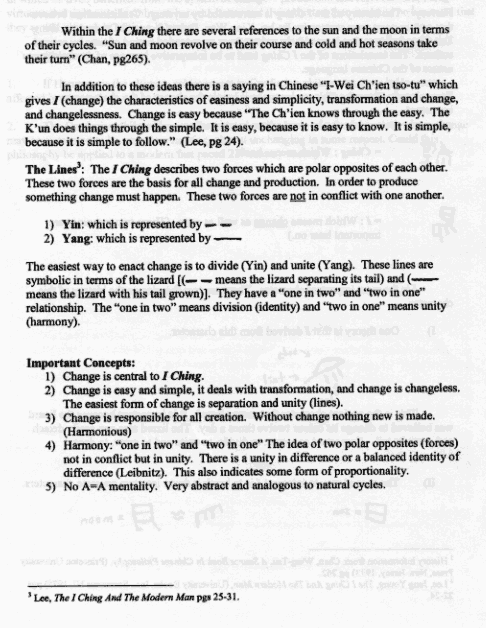 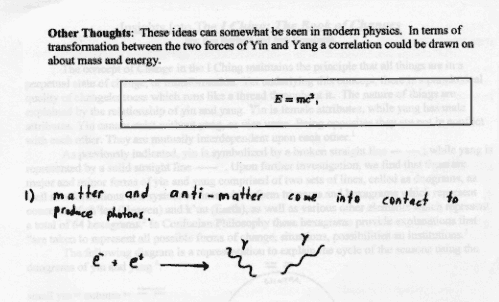   |
I Ching was identified as belonging to Confucianism. The Taoists have their own understanding of the text.
Philolophy of Nature:
What is nature? What is the nature of nature. Nature is basically change. The nature of nature is change. Change can be represented mathematically to a large extent, and is simple.
Today we look at Confucianism. Until now, Confucianism was the orthodox of Chinese philosophy. Their idea/point was elegance. They were intellectual/scholarly; emphasis was on education and scholarship. Confucius (551-479 BCE) has been identified as the greatest teacher in the history of China. Before him, education was not open to the public, it was primarily for the nobles. Anyone could become a student of Confucius, and he had 3,000 students. He loved to travel and went to small countries promoting his political ideas. His aim was to rehabilitate the social order. His approach was mainly ethical. Humanist turn [from Nature to Society] rose with Confucianism. The aim was to solve practical problems - socio-political issues. But what is "an ideal society"? In the hand of confucius an idea of a well-ordered society was introduced. Here we can discover a kind of socio-political harmony. There is analogy between nature and society - an ordered cosmos.
3 major stages in development of Confucianism:
Confucian major founders and philosophers they were like:
Confucius | Mencius | Hsun Tzu Socrates Plato Aristotle
During the 1st period, no one would 'buy' Confucianism. It enjoyed popularity, but just in society. During 2nd period, gradually Neo-Confucianism became an official philosophy. The Neo-Confucian are at the same time politicians, and politically powerful. Scholars tried to revive Confucianism in China in the 1930s. During the 2nd period, the major task is to defend Confucianism in the face of the challenge coming from Taoism and Buddhism. In the contemporary the major task is to defend against the challenge coming from the West; creating high tension between Chinese and Western philosophy. We will focus on the first two periods in this course.
Hegel mainly criticized Confucianism. Even though he criticized Taoism and Buddhism, he mainly targets Confucianism. Leibniz was into Confucianism, but with the transition from him to Hegel, the attitude towards Chinese philosophy changed. Heidegger was a friend of Taoism rather than Confucianism. In defending Taoism, Heidegger finds what is wrong with Hegel's understanding of Taoism.
Leibniz --> Hegel --> Heidegger Friendly to Confucianism criticized Chinese philosophy in general sees the future of Chinese philosophy
[practical implications to our contemporary world]
Confucianism is community oriented. If there is a conflict, it should be resolved for the good of the community. Taoism is more about the individual - individuals' rights and freedoms. Confucianism is part of why Communism rose in China. Apart from social relations, there is no individual.
|
Moral self-consciousness defines human nature, this shift of focus was attributed to Mencius. Confucius was primarily a teacher/master, Mencius was a philosopher.
The essential characteristics of Confucianism:
|
Student hand-outs for their seminars today: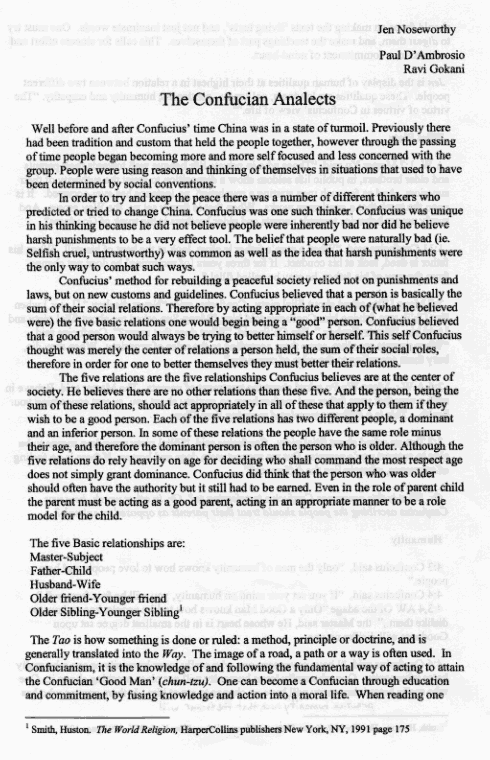 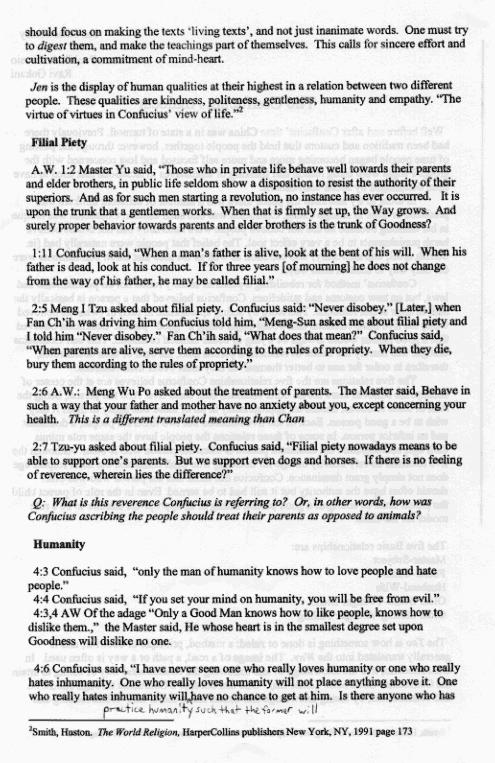 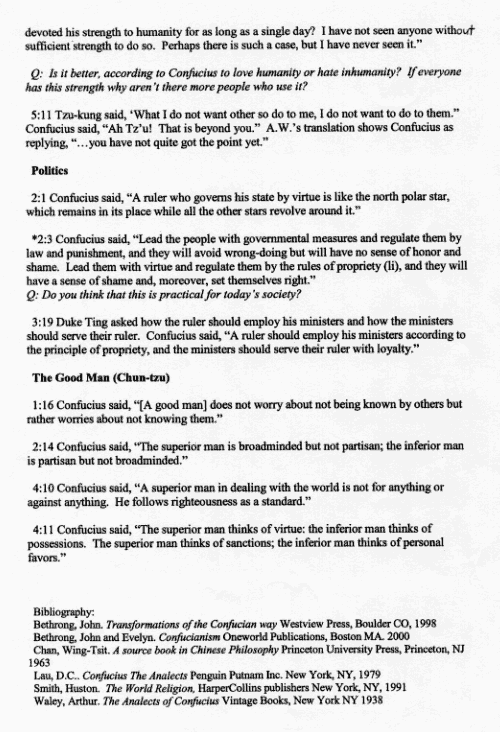 |
Student hand-outs for their seminars today: 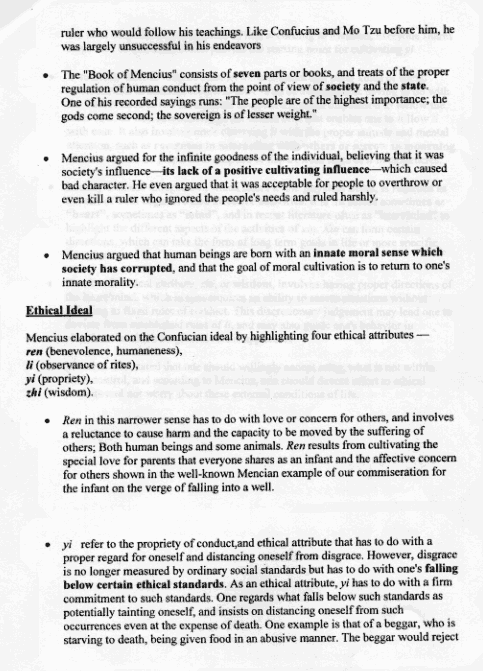 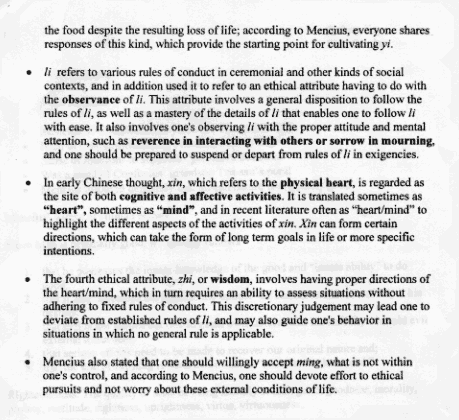   |
|
I. Mencius and Kao Tzu in Argumentation:
II. Hsun Tzu's Criticism of Mencius:
|
Thomas Hobbes (1588-1679)
|
| Everyone can become a sage | Mencius | Hsün Tzu |
| View | Idealistic: everyone can be a sage, because human nature is originally good | Realistic: there are very few sages, because everyone posesses the faculty to know correct principles, and the capacity to practice them, but they lack the effort |
| Methodology | top-down | bottom-up |
| Origin of moral code | internal | external |
| Consequence of moral action | Possibility is higher than actuality | Actuality is higher than possibility: "what is possible" is not the same as "what is able to be done." |
Student hand-outs for their seminars today: 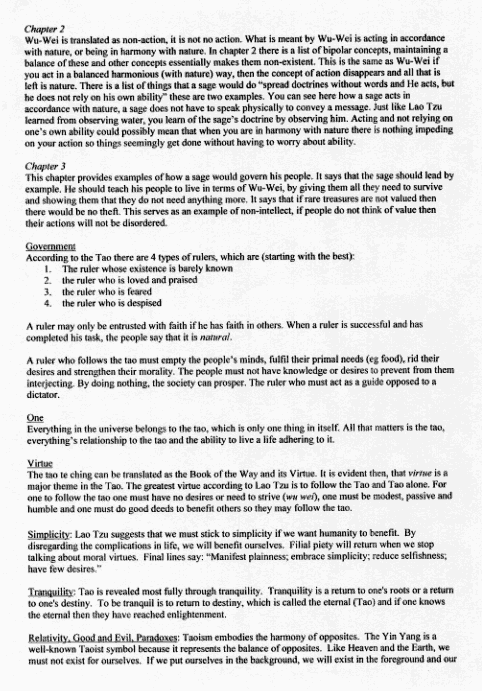  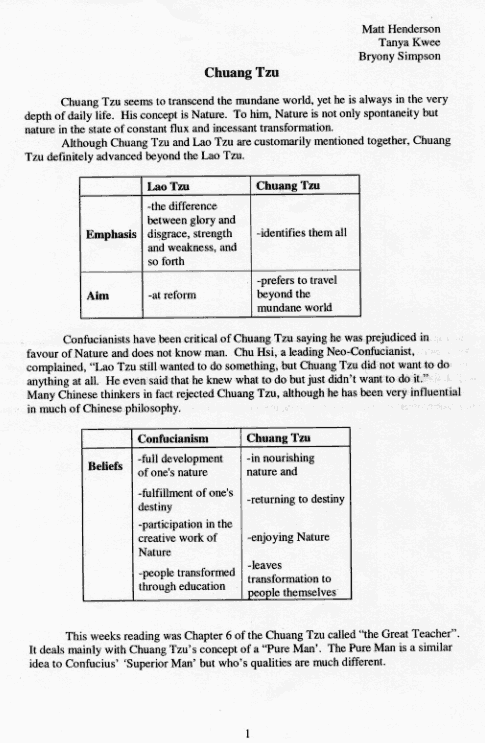  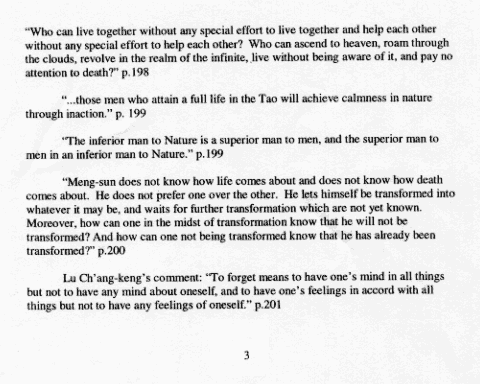 |
The Three Different Interpretations of Yin & Yang(1) The I Ching: Yang = Active Metaphysical Force Yin = Passive Mentaphysical Force (2) Lao Tzu: Yang = Unconcealment Yin = Concealment (3) The Yin Yang School: Yang: Active Material Force Yin: Passive material force |
Student hand-outs for their seminars today: 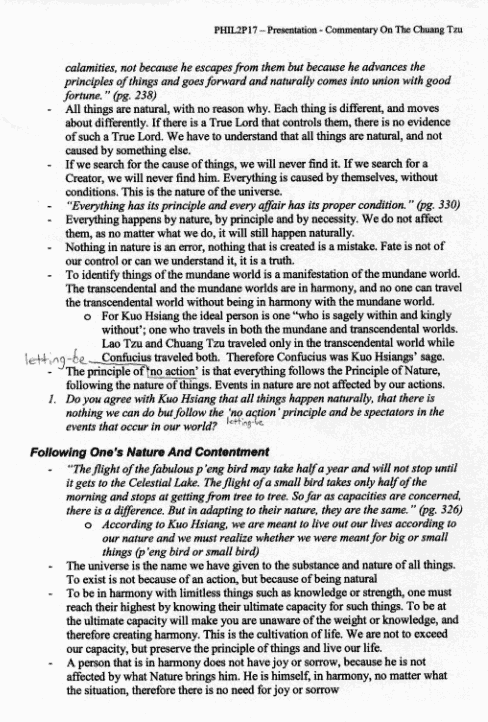    |
yin = passive, concealed
yang = active, unconcealment
yang = noumena -> super-sensible
vs.
yin =
phenomenon
-> sensible
Heidegger: "Nature loves to hide itself" [Heraclitus]
What's new in Neo-Taoism
(1) Tzu-jan (ereignis) becomes a key concept: Because Nature is the model of the Tao. (2) From Ground to Non-Ground: Because Nature means Non-ground (3) Differentiation of "Philosophical Taoism" from "Religious Taoism" (4) Primacy of the useless: The useless has the greatest use (5) Linguistic turn: with Lao Tzu and Chuang Tzu there was something negative about language (Nameless...), but now there is a rise of semeiotic hermeneutics (theory of interpretation) which treats language as index, signpost, instrument to help you reach the meaning |
Society and nature is the goal of Confucianism. On the other hand Taoism is mainly interested in nature. It signifies a kind of retreat from society. Lao Tzu's major concern is to search for some comprehensive principles underlying the development of history. Tao is a general pattern or principle. Originally Taoism and Confucianism are in a conflict situation, or at least tense. Neo-Taoist attempt to harmonize the two schools. Signifies return from nature to society - Neo-political or neo-social order. Taoist political philosophy, is what you get when you combine Taoism with Confucianism. Taoism is for hermits in a forrest. Neo-Taoism signifies the return of the hermits to this world.
Before Neo-Taoism, was the rise of religious Taoism. There is a difference between philosophical and religious Taoism. The purpose of the religious is to prolong their lives. To reach this goal they try to practice some rituals. Huge litterature on this topic, but it's nothing philosophical. How to become an angel, in a sense, is the major concept. In order to purify themselves from the religious Taoism, they try to clarify the basic ideas of Taoism philosophically. In the time of Lao Tzu there was no "religious Taoism" or people practicing like that. Neo-Taoists try to argue that the idea of a simple life is possible in this world.
Neo-Taoism's important figures: Wang Pi, Kuo Hsiang
"you are more than [just] what you are" more than your individuality, you have to go beyond yourself, society, blah blah.
Chang Tzu: being both A and non-A
you can't submit the other to yourself, that is the opposite of Tao; just be open to it
Neo-Taoism thesis of Wang Pi (that Kuo Hsiang attacked)
(1) Nothingness as a ground of the world
(2) The pre-existance of Nothingness
Principle of Sufficient Reason - Leibniz
Nothing is without ground(reason)
"Ohne Warum" ("Without Why")by Angelus Silisius (17th c.):
|
Buddhism originally came from India. umm.... the founder of um, Buddhism, ya? It's called, Shakyamuni. I have a chart of this. Nowadays india is much bigger. Its' the eastern part of indua. uh, north eastern [grumble]... As I mentioned in the introduction of the first week. particularly right now in Japan, um there's a very uh ahm uh .... many Japanese scholars claimed that when Buddhism was transimited from india to China, there was a kind of distortion under the influence of Taoism. Chinese created their own way in understanding Buddhism.
Critical Buddhism. Instead, ya? Critical Buddhism would claim that it's not eh Chinese Buddhism eh rather Tibetan Buddhism. which represents the original indian Buddhism. so um in a sense because the tibetan language was invent by sanscit. instead of translating sutras their language is developed from the Sutra. From a symantecs standpoint, Chinese sutras have been translated back into sanscrit; sometimes when scripts were lost or whatever.
Tibetan sutras are more faithful to the original sanscrit ones. for this reason tibetan Buddhism would be most authentic.
Professor Chan takes a moment to belittles us [the class], by telling us about our limited Canadian mentality and the fact that he is older so he knows more and understands better.
Indians cared about Brahmanism over Buddhism. Buddhism is the other of Brahmanism; there was tension right from the start.
Now he will go on to defend Chinese philisophical understanding of Buddhism. Chiense was radicalization of Indian Budhism. In the hands of Chinese, Buddhism came under influence of Taosim, so Buddhism was deepend in it's development in China. So I let you see how my justification would run.
So the Buddha Shakyamuni, historical Buddha. He was a prince. um, according to legend ah um he lived in the 6th century BC. So um in terms of uh uhm geography actually uh the historic Buddha was born in the um Nepal rather than India. the close to the himalaya. so um actually he got married before becoming a Buddha. um it's a legend i mean the in oriental world there's so many stories like this. the Buddha when he was born ya he could speak already. and speak loudly. i've become the lord/law of the whole world. that's legendary, i don't think so. so um actually he has a son even ya? His son's name is lohara. At age of 29 he [the Buddha] depart his palace to search for the darhma. Just like Tao in Chinese philosophy, dharma can be compared to Tao, but the meaning of darhma is ambiguous. Right now there are two major meanings principle/law and secondly just like existance/being. This two we should keep in mind. In sanscript truth is tatha. At age 35 he [the Buddha] attained enlightenment under a bodhi-tree, and age 80 he enter Nirvana that means be pass away. Major thing for us to understand [shows picture of temple] in 12th century when Islams/Muslims invade India, Buddhism was destroyed. In Sri Lanka is Hinayana Buddhism. In China, Japan, Korea, Vietnam, [...] Buddhism was Mahayana. the main thing about the essential teachings of Buddhism it's so called 3 darhmas or um i can give you a glimpse on the life of Buddha before we move on. his original name is Gotama, um can you see?
The Buddha:
623-543 BC (Theravada)
563-483 BC (Western Scholars)
463-383 BC (Japanese Scholars)
Born in Kapilavatthu
Father: King Suddhodana
Mother: Queen Maya
Wife: Princess Yosodhara
Son: Prince Rahula
In challenging Brahamanism or Hinduism Buddhism brought in 3 dharhmas.
Sometimes instead of the 3 dharmas we also define the essence of Buddhism in the Four Noble Truths:
1. dukha (suffering)
2. Samudaya (cause of suffering: desire)
3. Nirodha (extinction of Suffering: Nirvana)
4. Marga (path)
God = Brahman = world = atman
Professor Chan compares Brahman to God, and negative stuff about man never becoming or reaching God in Christianity, and about manifestation... impermanence vs. creator
37 stages of Marga? or to get rid of suffering/desire.
Buddhists are Atheist. Theo is Greek term for God. but then how can you explain the origin of this world. Leibniz: "Is there something rather than nothing?" Pratitya-sam-utpada. dependant co-origination. pratitya means conditions. sam is co . utpada means to arise. nothing is self-sufficient. nothing is self-subsistant. everything must depend on everything else to arise. there's no actual beginning, and there is no end-point. the arising of anything must depend on the other.
Note: I conceive that "God" is the other of consciousness and reality.
So, there is Mahayana and Hinayana. Historically Mahayana came first.
Hinayana Buddhism
|
samsara = this world, Nirvana = the other world. there is a distinction between these two. samsara is the world of birth and death.
niv(no)sva(self)bhava(being)
on the other hand we have Mahayana Buddhism. maha means great.
Mahayana Buddhism
1. Bodhisattva is a prerequisite for attaining Buddhahood
2. Non-dweeling Nirvana
3. Nirvana is identical with samsara
4. Aims at the emancipation of all
5. The primacy of ethics: Compassion
6. Sunyata of human being and the world as well
7. Sunyata-asvabhava
Hinayana is selfish - individual emancipation - they don't care about the other. in contrast, with the rise of Mahayana, there's a turn to the idea of great compassion. there is a kind of great love, you can say. so if the other suffers, the bodhisatva suffers as well; the ideal of great compassion. Mahayana Buddhists are ethical in character because of the concern for the other.
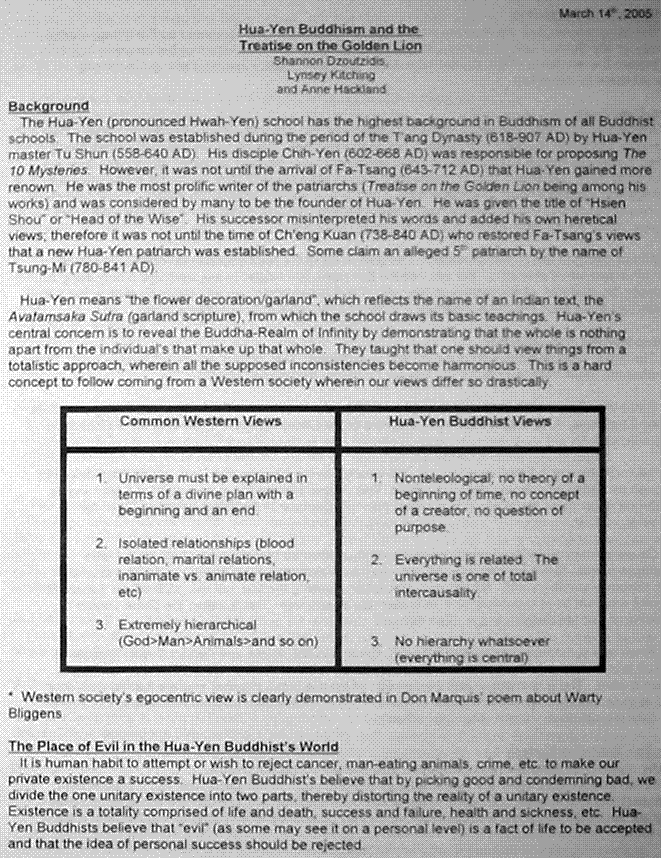

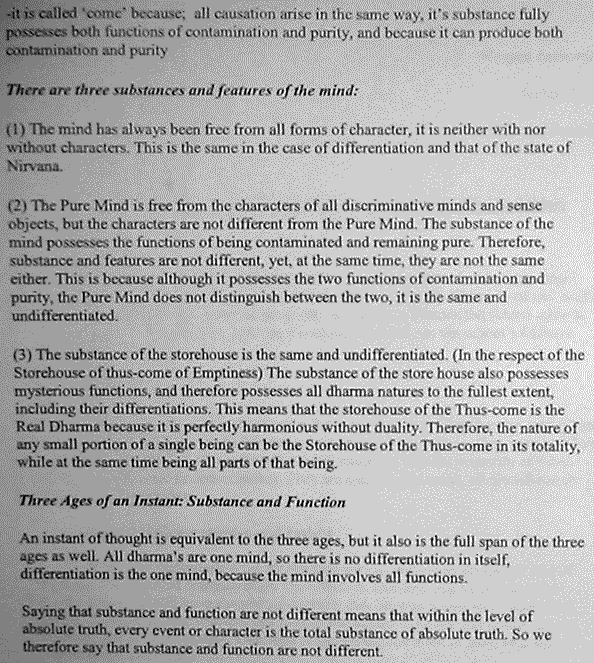

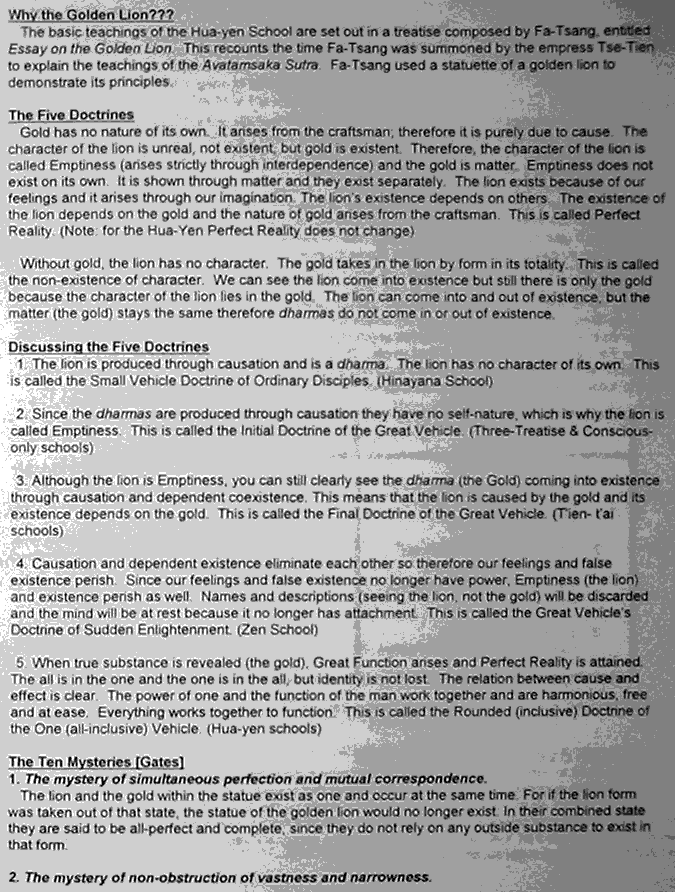
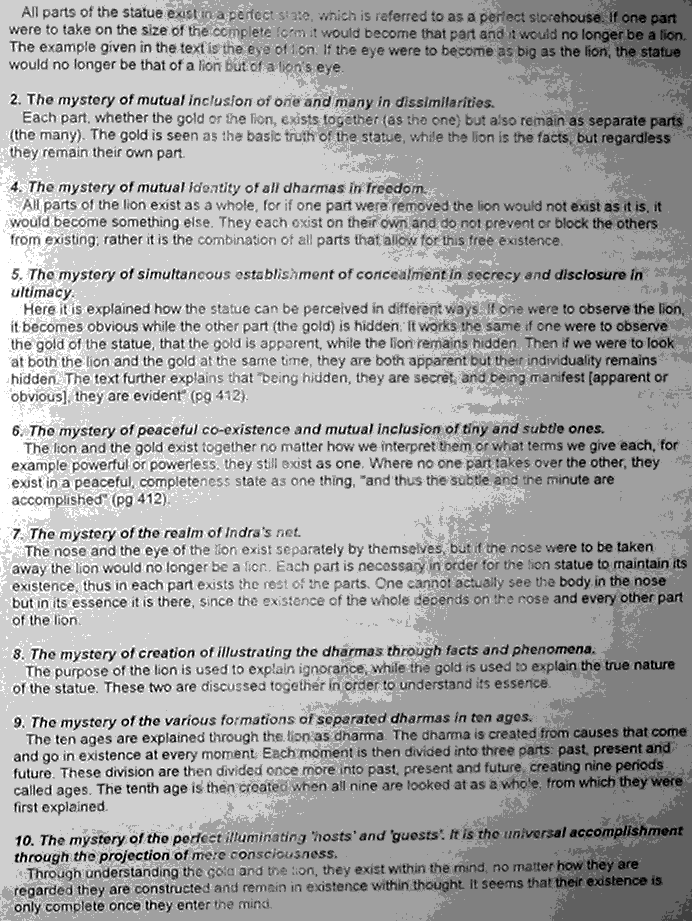
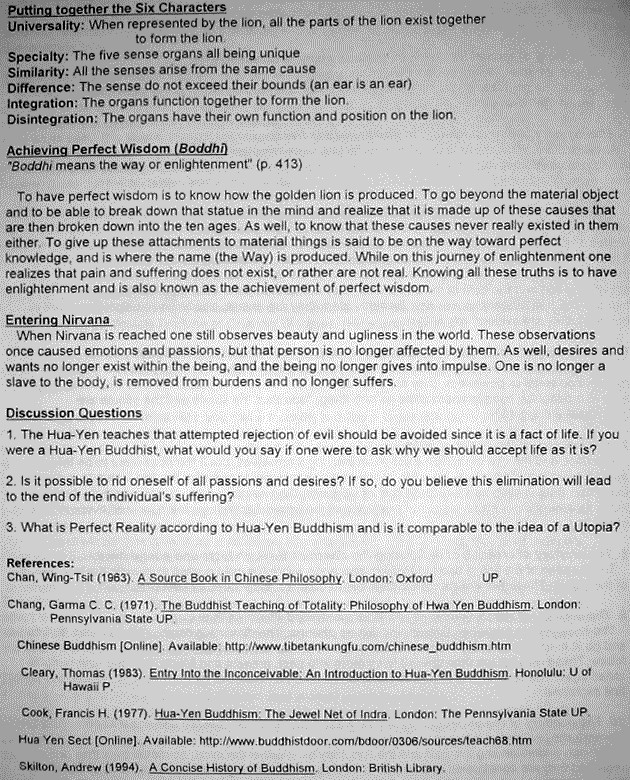
I did not manage to type all of Prof. Chan's talking, due to using my laptop in presenting.
The T'ien-t'ai <-> Heidegger
|
| Heidegger Man is Being-in-the-world (In-der-welt-sein)
world: a set of existential possibilities (sein-lassen)
Being (Way) = the non-ground = letting-be = |
The Madhyamika - The Middle School sunya = empty |
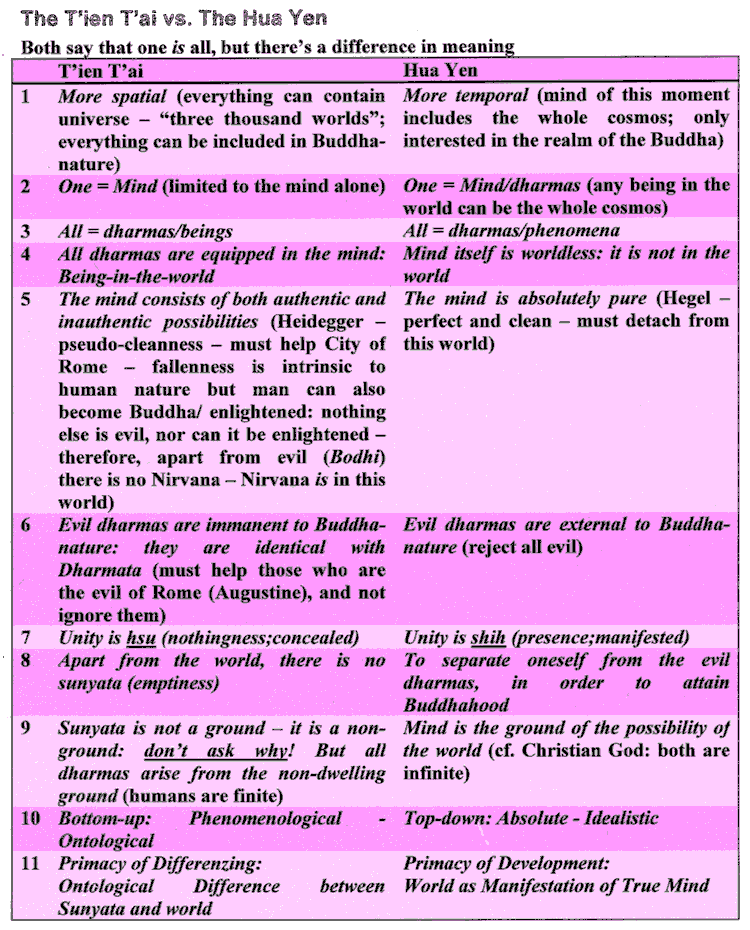
"Zen Buddhism" presentation continued today, followed by presentations on "Chu Shi", and finally "The Complete Works of Lu Hsiang-Shan".
I did not manage to type notes for today (like last week), due to my laptop's use in presenting.
Hand-outs:

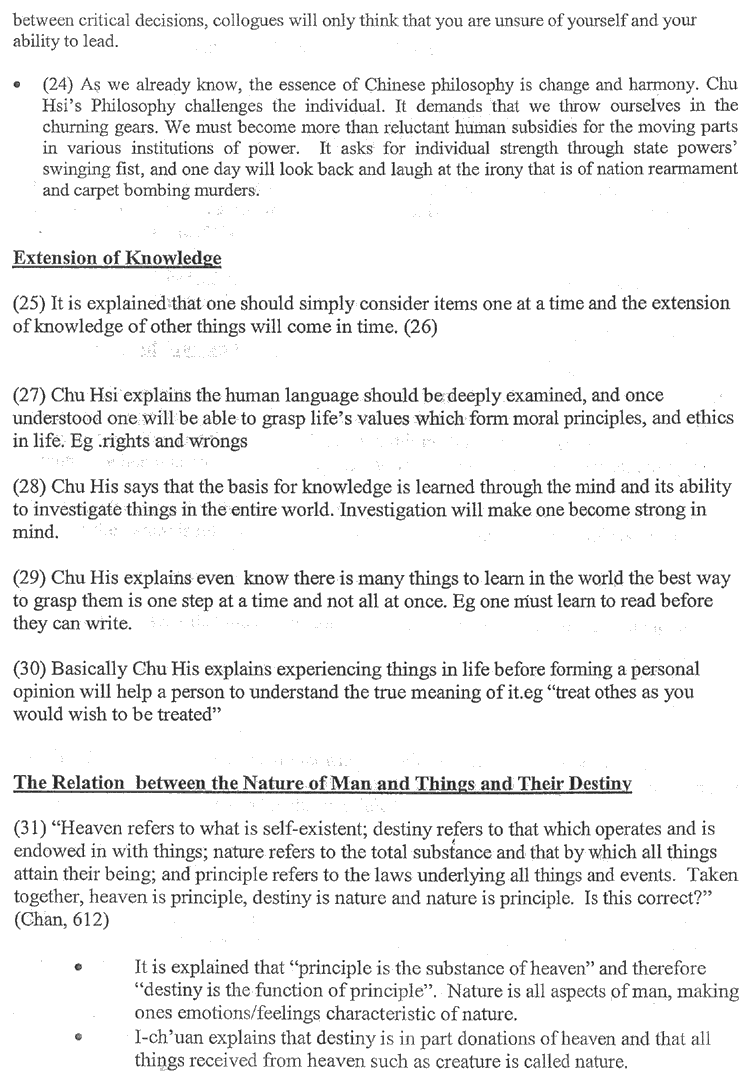
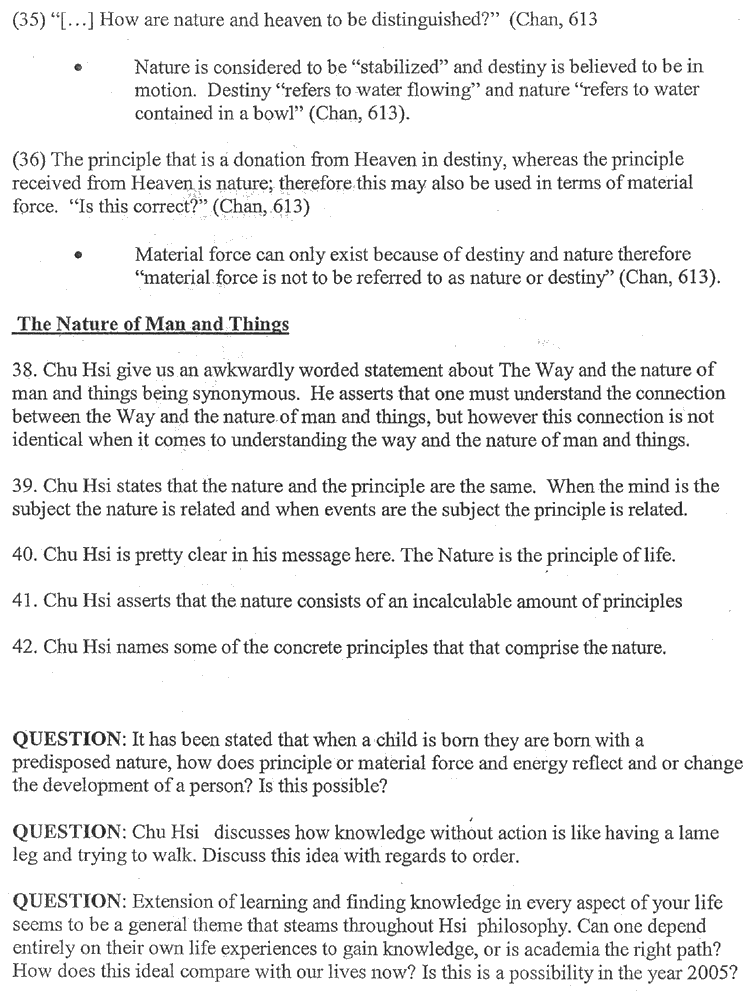
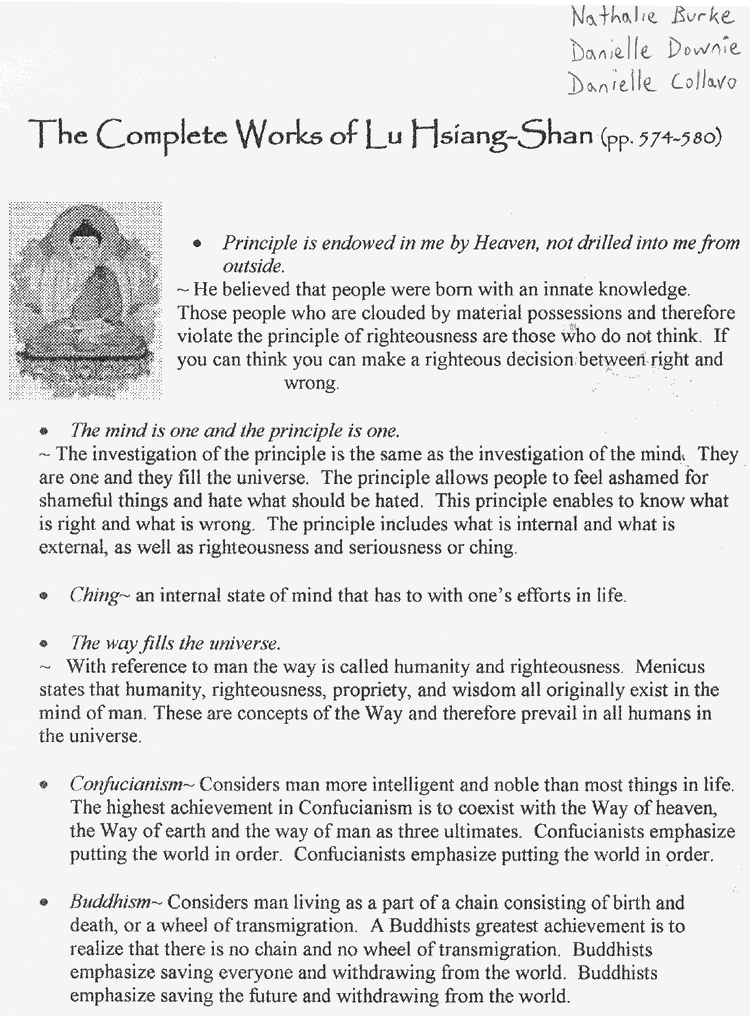
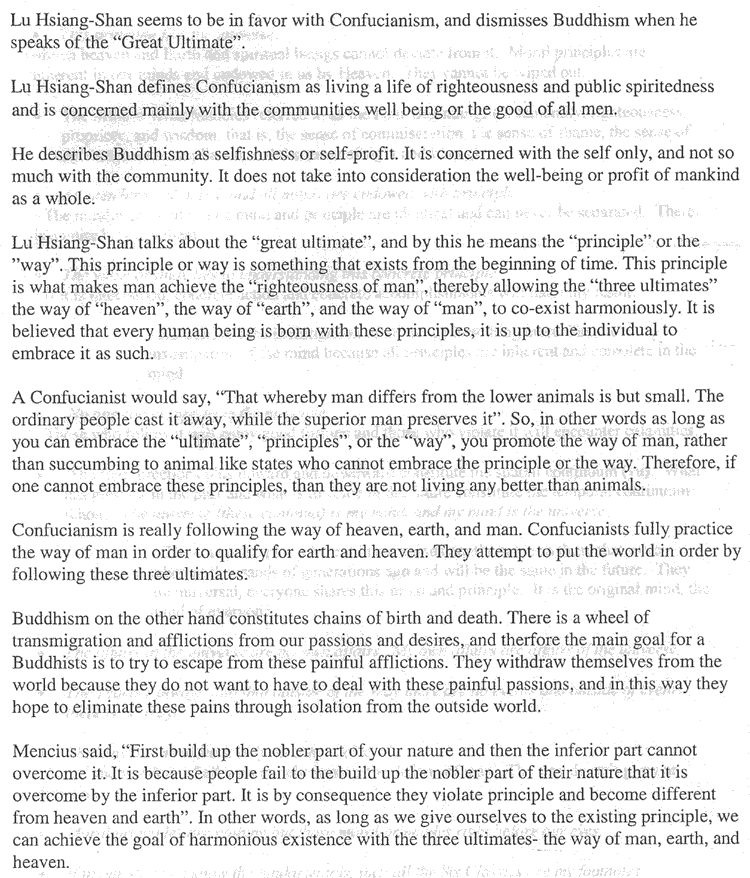
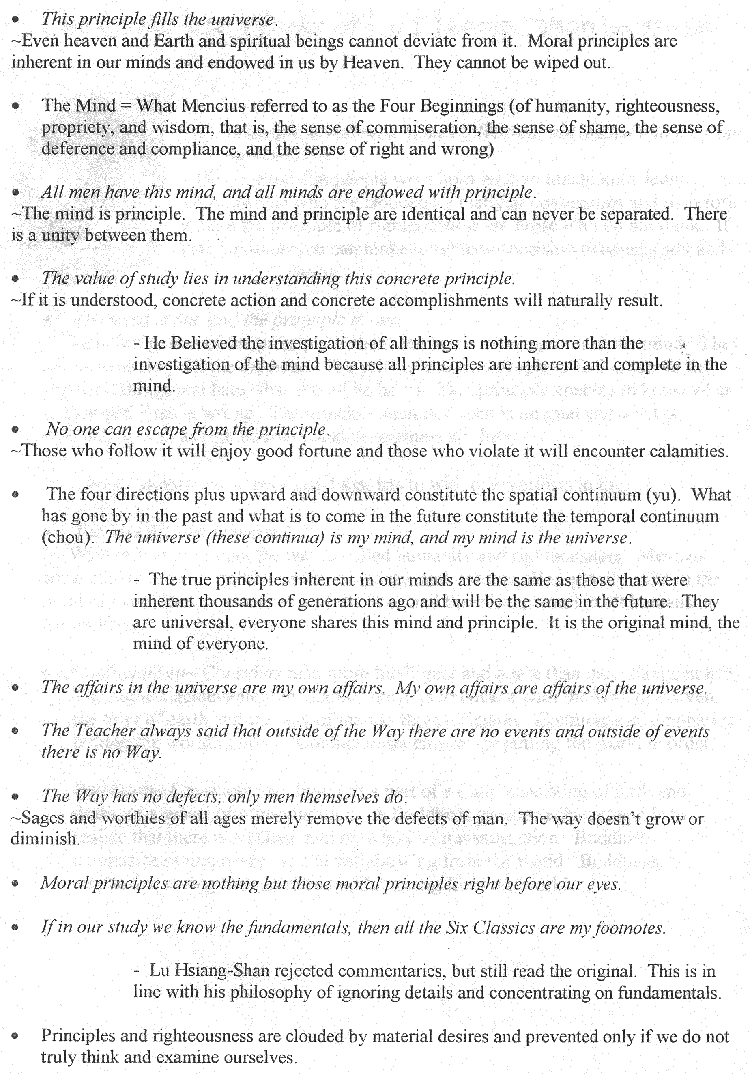
Student hand-outs for their seminars today:  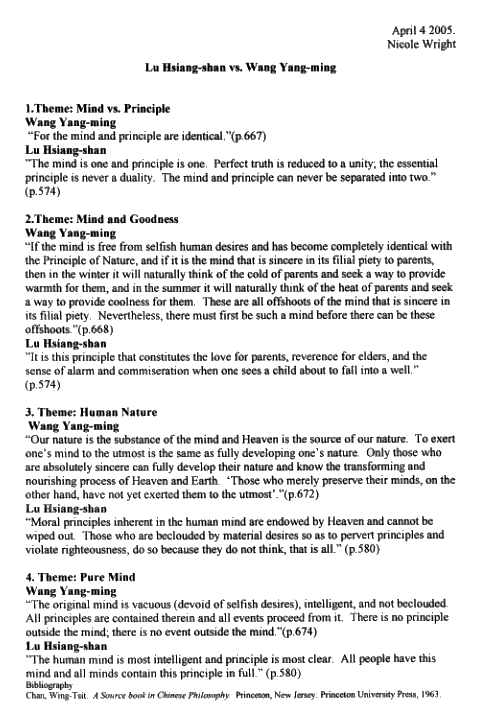 |
Chinese Buddhism is a continuation of Indian Buddhism. First regarding debate between Chu Hsi and Lu Hsiung-Shan in Neo Confucianism. It was held in a place called Goose Lake. Sometimes called Goose Lake debate. Very famous debate and place. Important thing is to understand the philosophical significance of this debate. Scholars like Win Tsit Chan (who even claimed that Chu Hsi was most important Chinese Philosopher) would appreciate Chu Hsi. Rise of Chu Hsi's philosophy signifies the completion of Chinese philosohpy. Personally Prof Chan does not buy this thesis, but in conclusion some indications why such a thesis might be contraversial in a sense. ya? I can give the highlight of this debate.
Chu Hsi(1) Nature (hsing) = Principle (li) (2) Principle and the material force (ch'i) are sharply different (3) Principles are external to our mind (4) The Great Ultimate (t'ai-chi) is above yin and yang which are the passive and active material force (5) The investigation of things aims at grasping the principle in things (6) Wesensethik (Ethics of Essence) (7) Realism (8) Human mind (jan-hsin) is finite, it is Wilkuer (volition); Moral mind (tao-hsin) is infinite, it is pure nous (spirit). |
Lu Hsiang-shan(1) Mind (hsin) = Principle (li) (2) Both yin and yang are non-sensible forces (3) Principles are immanent to our mind (4) The Great Ultimate (t'ai-chi) is the highest good. It is one with ch'i which is spiritual force (5) The investigation of things = the investigation of mind (6) Richtungsethik (Ethics of Direction) (7) Idealism (8) Mind = Wille (Will); Human mind = Tao |
In comparison with Western Philosophy, Chu Hsi is like Chinese Fable (like Plato), on other hand Lu Hsiang-shan looks like Kant (Plato vs. Kant). Why? because essence, item #6, in Chu Hsi can be compared to Platos Idea/Eidos. According to Plato, everything manifests from idea. But according to Plato, prior to our cognition of these concepts, they existed already. In the case of Chu Hsi in contrast to Plato the content the knowledge of an idea/eidos serve our modern practices. there's an element of morality/ethics, and same with Plato. For Plato, every idea has an absolute value. an idea is at the same time a value. so it has a kind of axiological meaning on top of ontological meaning. an idea explains the grounds of what a being things. at same time it set an absolute standard for the beings. for example, every triangle... axiological -> the highest and/or most perfect [significance, value, standard, measure]. Ontological -> why. agathon = The Highest Good in Greek. Chu Hsi used term Principle or Nature instead of idea. Plato's buddy Aristotle preferred Essence. The Principle functions as the standard (the moral principle, [ethical/social] norms), so you know how to behave yourself in order to be moral/ethical. So, you have to learn! For Chu Hsi you can say so, our moral knowledge is not innate - you have to learn.
Eidetic(non-sensible) seeing - goes on about a piece of chalk, writing function is essential to a piece of chalk, a triangle is something of three lines, a cup most work as a container
Puts up slide of The Hsun Tzu, Chapter 29.
Kant's categorical imperative
To act according to a maxim as it can be willed to be universalizable
Mother Teresa and universalizability
Chu Hsi's Approach(1) Community-Centric: The Priority of Common Good (2) Defense for Traditional and Communal Values (3) Virtue-Centric: The Primacy of Action (4) Methodology: Learning the Li (Principle) by means of Investigation of Things -> (i) The Rationality for which things and affairs are as they are [= Essence] (5) One should learn throughout life, in order to overcome one's own one-sidedness and narrowness of view by establishing harmonizing relationships with others through participation in shared rituals (6) The Primacy of the Sittlichkeit |
Ethos (Greek) means Ethics, but originally meant customs/heritage.
Hegel: Moralitay (subject, individual) vs Sittlichkeit (intersubjective, social)
Lu Hsiang-shan's Approach(1) Subject-Centric: The Priority of Individual Autonomy (2) Self-Determination of Moral Laws (3) Conscience-Centric: The Primacy of Will (4) Methodology: Self-Reflection (5) "True to Oneself" is the Highest Principle (6) The Primacy of Moralitaet |
What is Neo-Confucianism?[1] A renaissance of Confucianism in responding to Buddhism and Taoism: Aiming at return to this world as primarily an ethical life, in the meantine to disclose the transcendental significance of moral praxis [2] The Metaphysical Turn of Confucianism: In Adressing social-political issues, it also reveals its ontocosmological implications [3] System-Building: The Development of Moral-Metaphysics Confucianism is articulated as doctrines of Mind, Li (Principle), Ch'i (force) and Tai-chi (the Primal One) which are coupled to Jen (benevolence) and Yi (justice) [4] Harmony in an Onto-Cosmological Sense: Harmony is not just to be established on the social-ethical order, but is primarily to be realized between man and Heaven: the rise of the concept of T'ien-tao (Tao of Heaven) [5] Clarification of the Origin of Evil: In intimating Buddhism it identifies desire as the cause of evil [6] Clarification of the Origin of the Cosmos: Tai-chi = Origin of Cosmos Ch'i = the principle of actualization |
Chan: "Praying is the communication between Human Beings and God"
Last of Neo Confucian stuff... Wang Yang-ming
The Autonomy of the WillLu Hsiang-shan, Wang Yang-ming, Kant Autonomy of the will is that property of it by which it is a law to itself independently on any property of the objects of volition) |
The Heteronomy of the WillChu Hsi, Plato If the will seeks the law which is to determine it anywhere else than in the fitness of its maxims to be universal laws of its own dictation, consequently if it goes out of itself and seeks this law in the character of any of its objects, there always results heteronomy. The will in that case does not give itself the law, but it is given by the object through its relation to the will. This relation, whether it rests on inclination or on conceptions of reason, only admits of hypothetical imperatives: I ought to do so and so because I wish for something else |
Toward a Rational Society(1) Confucian ethics is primarily community-centric. Common good consists in a shared life as defined by a network of roles specifying the contribution of each member to the sustenance of the community. (2) For Confucius, ehtical order must be supplemented by sincerity of each member. (3) But the priority of community can easily give rise an oppressive society. In fact, nowadays Chinese society remains authoritarian. (4) Chu Hsi's way out: valid norms must be grounded upon universal principles. "To investigate principle to the utmost means to seek to know the reason for which things and affairs are as they are and the reason according to which they should be." (5) Lu-Wang's way out: my will is the ultimate ground for moral norms. This points to a turn towards inwardness. Accordingly, it grants a priority to the individual over the community (6) A Habermasian solution of the debate between Chu Hsi and Lu-Wang: "the principle of justification of norms is no longer the monological applicable principle of universalizability but the communally followed procedure of redeeming the normative validity claims discursively." (7) But in contrast to Habermas's self-understanding, the principle of discourse ethics is here understood as a principle of critique, rather than a principle of foundation. That is, its function lies in keeping the society open. (8) In terms of such a critical control, the society can be prevented from being oppressive or authoritarian. In a society mediated by the undistorted, uncoercive rational discussion, the harmony between community and individuals can be re-established. |
Some Major Distinctions between Indian and Chinese Buddhism(1) Hinayana Buddhism was a major trend in India. (2) The tathagata-garbha was marginal in India. (3) Mind was a negative concept in Indian Buddhism. (4) Indian Buddhism stressed the complication and difficulty in praxis and meditation. (5) Meditation played a key role in Indian Buddhist doctrine of praxis. (6) Indian Buddhism struggled to transcend this world, in order to reach Nirvana. (7) The Indian Buddhist doctrine of karma pointed to the idea of endless lives. (8) Indian Buddhism was more intellectual and theoretic in orientation; it aimed at explanation of the world. |